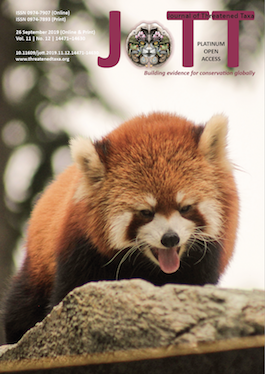Australasian sequestrate Fungi 20: Russula scarlatina (Agaricomycetes: Russulales: Russulaceae), a new species from dry grassy woodlands of southeastern Australia
Main Article Content
Abstract
Russula scarlatina sp. nov. is a common sequestrate fungus found in the dry sclerophyll Eucalyptus woodlands of southeastern Australia. Basidiomata are hypogeous or sometimes emergent; they are scarlet in youth and become dark sordid red or brown with advanced age. Historically, this species would have been placed in the genus Gymnomyces, but in light of recent revisions in the taxonomy of sequestrate Russulaceae, we place it in the genus Russula. It is morphologically distinct from other sequestrate species of Russula because of its scarlet peridium and unusual cystidial turf in youth. It has been collected only in dry grassy woodlands and open forest habitats of southeastern Australia.
Article Details
Authors own the copyright to the articles published in JoTT. This is indicated explicitly in each publication. The authors grant permission to the publisher Wildlife Information Liaison Development (WILD) Society to publish the article in the Journal of Threatened Taxa. The authors recognize WILD as the original publisher, and to sell hard copies of the Journal and article to any buyer. JoTT is registered under the Creative Commons Attribution 4.0 International License (CC BY), which allows authors to retain copyright ownership. Under this license the authors allow anyone to download, cite, use the data, modify, reprint, copy and distribute provided the authors and source of publication are credited through appropriate citations (e.g., Son et al. (2016). Bats (Mammalia: Chiroptera) of the southeastern Truong Son Mountains, Quang Ngai Province, Vietnam. Journal of Threatened Taxa 8(7): 8953–8969. https://doi.org/10.11609/jott.2785.8.7.8953-8969). Users of the data do not require specific permission from the authors or the publisher.
References
Australian Department of the Environment Water, Heritage and the Arts (2010). Gippsland Red Gum Grassy Woodland and Associated Native Grassland. Australian Department of the Environment Water, Heritage and the Arts. Canberra, 41pp.
Elliott, T.F. & K. Vernes (2019). Superb Lyrebird Mycophagy, Truffles, and Soil Disturbance. IBIS 161(1): 198–204. https://doi.org/10.1111/ibi.12644
Elliott, T.F. & J.M. Trappe (2018). A worldwide nomenclature revision of sequestrate Russula species. Fungal Systematics and Evolution 1(1): 229–242. https://doi.org/10.3114/fuse.2018.01.10
Galante, T.E., T.R. Horton & D.P. Swaney (2011). 95% of basidiospores fall within 1m of the cap: a field-and modeling-based study. Mycologia 103(6): 1175–1183. https://doi.org/10.3852/10-388
Lebel, T. (2017). Nomenclatural changes and corrections for some previously described Australasian truffle-like fungi (Basidiomycetes). Muelleria 36(8): 8–14. https://www.rbg.vic.gov.au/documents/Muelleria_Vol_36_-_p8_Lebel_Nomenclatural_truffle-like.pdf
Lebel, T. & J.E. Tonkin (2007). Australasian species of Macowanites are sequestrate species of Russula (Russulaceae, Basidiomycota). Australian Systematic Botany 20(4): 355–381. https://doi.org/10.1071/SB07007
Lebel, T. (1998). Taxonomic revision of the sequestrate relatives of Russula from Australia and New Zealand. PhD Thesis, Oregon State University, USA.
McIntyre, S., J. Stol, J. Harvey, A.O. Nicholls, M. Campbell, A. Reid, A.D. Manning & D. Lindenmayer (2010). Biomass and floristic patterns in the ground Layer vegetation of box-gum grassy eucalypt woodland in Goorooyarroo and Mulligans Flat Nature Reserves, Australian Capital Territory. Cunninghamia 11(3): 319–357.
Nuske, S.J., K. Vernes, T.W. May, A.W. Claridge, B.C. Congdon, A. Krockenberger & S.E. Abell (2017a). Redundancy among mammalian fungal dispersers and the importance of declining specialists. Fungal Ecology 27(A): 1–13. https://doi.org/10.1016/j.funeco.2017.02.005
Nuske, S.J., K. Vernes, T.W. May, A.W. Claridge, B.C. Congdon, A. Krockenberger & S.E. Abell (2017b). Data on the fungal species consumed by mammal species in Australia. Data in Brief 12: 251–260. https://doi.org/10.1016/j.dib.2017.03.053
Thiers, H.D. (1984). The secotioid syndrome. Mycologia 76(1): 1–8. https://doi.org/10.2307/3792830
Trappe, J.M. & A.W. Claridge (2005). Hypogeous fungi: evolution of reproductive and dispersal strategies through interactions with animals and mycorrhizal plants, pp. 613–623. In: Dighton, J., J.F. White & P. Oudemans (eds.). The Fungal Community—Its Organization and Role in the Ecosystem. 3rd Edition. Taylor and Francis, USA, xx+936pp.
Vernes, K. & L. Dunn (2009). Mammal mycophagy and fungal spore dispersal across a steep environmental gradient in eastern Australia. Austral Ecology 34(1): 69–76. https://doi.org/10.1111/j.1442-9993.2008.01883.x

